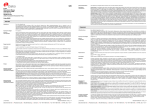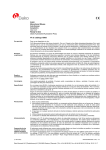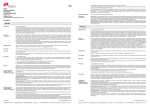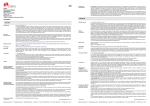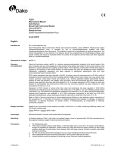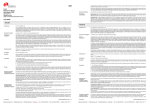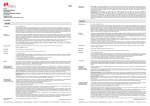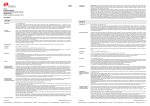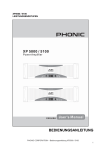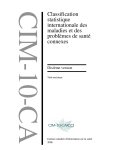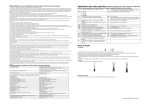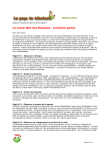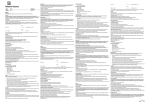Download FLEX Monoclonal Mouse Anti-Human Amyloid A Clone mc1
Transcript
Optimal conditions may vary depending on specimen and preparation methods, and should be determined by each individual laboratory. If the evaluating pathologist should desire a different staining intensity, a Dako Application Specialist/Technical Service Specialist can be contacted for information on re-programming of the protocol. Verify that the performance of the adjusted protocol is still valid by evaluating that the staining pattern is identical to the staining pattern described in “Performance characteristics”. FLEX Monoclonal Mouse Anti-Human Amyloid A Clone mc1 Ready-to-Use (Dako Autostainer/Autostainer Plus) Counterstaining in hematoxylin is recommended using EnVision FLEX Hematoxylin, (Dako Autostainer/Autostainer Plus) (Code K8018). Non-aqueous, permanent mounting medium is recommended. Positive and negative controls should be run simultaneously using the same protocol as the patient specimens. The positive control tissue should include kidney with amyloidosis and the cells/structures should display reaction patterns as described for this tissue in “Performance characteristics” in all positive specimens. The recommended negative control reagent is FLEX Negative Control, Mouse, (Dako Autostainer/Autostainer Plus) (Code IS750). Code IS605 Staining interpretation Amyloid A labeled by the antibody has an extracellular localization in the majority of cases. Performance characteristics Normal tissues: The antibody does not label normal tissue (5). However, the antibody occasionally labels serum. Abnormal tissues: The antibody labeled amyloid A in renal and rectal biopsies of patients with inflammatory pediatric disease (1). Tissues from patients with a clinical diagnosis of rheumatoid arthritis, sporadic Muckle-Wells syndrome, idiopathic polyneuritis, idiopathic amyloidosis, familial Mediterranian fever, and Still’s syndrome were also labeled (5). In kidney, large smooth muscle cells with deposits of amyloid A show a moderate to strong staining reaction, whereas basal membranes of renal glomeruli with amyloid A deposits show a weak to moderate staining reaction. ENGLISH Intended use For in vitro diagnostic use. FLEX Monoclonal Mouse Anti-Human Amyloid A, Clone mc1, Ready-to-Use (Dako Autostainer/Autostainer Plus), is intended for use in immunohistochemistry together with Dako Autostainer/Autostainer Plus instruments. This antibody labels amyloid A (AA) in tissues, and is useful for the identification and classification of AA-amyloidosis (1). The clinical interpretation of any staining or its absence should be complemented by morphological studies using proper controls and should be evaluated within the context of the patient's clinical history and other diagnostic tests by a qualified pathologist. Summary and explanation Amyloidosis is a group of diseases that have in common the extracellular deposition of fibrillar proteins with a specific biochemical conformation known as ß-pleated sheets. Approximately 20 different precursor proteins that may be deposited as amyloid fibrils have been identified (2). Amyloid proteins deposited in the tissues can be identified by Congo Red staining, and chemically classified via amino acid sequence studies, by immunohistochemistry, or via immunocytochemistry (1). Amyloid A (AA) is an extracellular deposited insoluble fibrillar protein, highly resistant to proteolytic degradation, and produced from the precursor protein, serum amyloid A (SAA) (2). Before the therapy of a suspected amyloid disease can be planned, both the presence of amyloid and its chemical origin must be known (3). Refer to Dako’s General Instructions for Immunohistochemical Staining or the detection system instructions of IHC procedures for: 1) Principle of Procedure, 2) Materials Required, Not Supplied, 3) Storage, 4) Specimen Preparation, 5) Staining Procedure, 6) Quality Control, 7) Troubleshooting, 8) Interpretation of Staining, 9) General Limitations. Reagent provided Ready-to-use monoclonal mouse antibody provided in liquid form in a buffer containing stabilizing protein and 0.015 mol/L sodium azide. Clone: mc1 (4, 5). Isotype: IgG2a, kappa. Immunogen An equal mixture of human amyloid A coupled to horseradish peroxidase and human amyloid A coupled to high molecular weight kininogen (5). Specificity In micro-ELISA, the antibody reacts with amyloid A and the serum precursor of amyloid A indicating cross-reactivity among amyloid A protein and the serum precursor of amyloid A. In contrast, no reactivity to other non-AA amyloid fibril proteins or human serum proteins, such as albumin, transferrin, and IgG is seen (4, 5). As demonstrated by immunohistochemistry on formalin-fixed, paraffin-embedded tissue sections, the antibody labels tissues from AA patients, but shows no reactivity with a host of unknown antigens in tissue sections of various organs (5), nor with amyloid types Aκ, Aλ, and amyloid fibril proteins in familial amyloid polyneuropathy and senile cardiovascular amyloidosis, respectively. Neither are Alzheimer’s amyloid plaques, amyloid in microangiopathy, lichen amyloidosis, and senile islets of Langerhans labeled by the antibody (5-7). Precautions 1. For professional users. 2. This product contains sodium azide (NaN3), a chemical highly toxic in pure form. At product concentrations, though not classified as hazardous, sodium azide may react with lead and copper plumbing to form highly explosive build-ups of metal azides. Upon disposal, flush with large volumes of water to prevent metal azide build-up in plumbing. 3. As with any product derived from biological sources, proper handling procedures should be used. 4. Wear appropriate Personal Protective Equipment to avoid contact with eyes and skin. 5. Unused solution should be disposed of according to local, State and Federal regulations. Storage Store at 2-8 °C. Do not use after expiration date sta mped on vial. If reagents are stored under any conditions other than those specified, the conditions must be verified by the user. There are no obvious signs to indicate instability of this product. Therefore, positive and negative controls should be run simultaneously with patient specimens. If unexpected staining is observed which cannot be explained by variations in laboratory procedures and a problem with the antibody is suspected, contact Dako Technical Support. Specimen preparation including materials required but not supplied Staining procedure including materials required but not supplied The antibody can be used for labeling formalin-fixed, paraffin-embedded tissue sections. Tissue specimens should be cut into sections of approximately 4 µm. Pre-treatment with heat-induced epitope retrieval (HIER) is required using Dako PT Link (Code PT100/PT101). For details, please refer to the PT Link User Guide. Optimal results are obtained by pretreating tissues using EnVision FLEX Target Retrieval Solution, High pH (50x) (Code K8010/K8004). Paraffin-embedded sections: Pre-treatment of formalin-fixed, paraffin-embedded tissue sections is recommended using the 3-in-1 specimen preparation procedure for Dako PT Link. Follow the pre-treatment procedure outlined in the package insert for EnVision FLEX Target Retrieval Solution, High pH (50x) (Code K8010/K8004). Note: After staining the sections must be dehydrated, cleared and mounted using permanent mounting medium. Deparaffinized sections: Pre-treatment of deparaffinized formalin-fixed, paraffin-embedded tissue sections is recommended using Dako PT Link and following the same procedure as described for paraffin-embedded sections. After staining the slides should be mounted using aqueous or permanent mounting medium. The tissue sections should not dry out during the treatment or during the following immunohistochemical staining procedure. For greater adherence of tissue sections to glass slides, the use of FLEX IHC Microscope Slides (Code K8020) is recommended. FRANÇAIS Utilisation prévu Pour utilisation lors d’un diagnostic in vitro. FLEX Monoclonal Mouse Anti-Human Amyloid A, Clone mc1, Ready-to-Use (Dako Autostainer/Autostainer Plus), est destiné à une utilisation en immunohistochimie avec les instruments Dako Autostainer/Autostainer Plus. Cet anticorps marque l'amyloïde A (AA) dans les tissus et permet l'identification et la classification des amyloïdoses AA (1). L’interprétation clinique de toute coloration ou son absence doit être complétée par des études morphologiques en utilisant des contrôles appropriés et doit être évaluée en fonction des antécédents cliniques du patient et d’autres tests diagnostiques par un pathologiste qualifié. Résumé et explication L'amyloïdose est un groupe de maladies qui ont en commun un dépôt extracellulaire de protéines fibrillaires avec une conformation biochimique spécifique, connue sous le nom de feuilles plissées de type ß. Environ 20 protéines précurseurs différentes peuvent ainsi être déposées, comme on a pu le déterminer dans les fibrilles amyloïdes (2). Les protéines amyloïdes déposées dans les tissus peuvent être identifiées par la coloration Rouge Congo, et classées chimiquement par l'étude des séquences d'acides aminés, par immunohistochimie ou immunocytochimie (1). L'amyloïde A (AA) est une protéine fibrillaire non soluble déposée au niveau extracellulaire, hautement résistante à la dégradation protéolytique, et produite par la protéine précurseur, le sérum amyloide A (SAA) (2). Avant de pouvoir instaurer le traitement d'une suspicion de maladie amyloïde, la présence de l'amyloïde et son origine chimique doivent être connues (3). Se référer aux Instructions générales de coloration immunohistochimique de Dako ou aux instructions du système de détection relatives aux procédures IHC pour plus d’informations concernant les points suivants : 1) Principe de procédure, 2) Matériels requis mais non fournis, 3) Conservation, 4) Préparation des échantillons, 5) Procédure de coloration, 6) Contrôle qualité, 7) Dépannage, 8) Interprétation de la coloration, 9) Limites générales. Réactifs fournis Anticorps monoclonal de souris prêt à l’emploi, fourni sous forme liquide dans un tampon contenant une protéine stabilisante et 0,015 mol/L d’azide de sodium. Clone : mc1 (4, 5). Isotype : IgG2a, kappa. Immunogène Un mélange égal d'amyloïde humaine A couplée à de la peroxydase de raifort, et d'amyloïde humaine A couplée à un kyninogène de poids moléculaire élevé (5). Spécificité Dans un micro-test ELISA, l'anticorps réagit avec l'amyloïde A et le sérum précurseur de l'amyloïde A, indiquant une réactivité croisée entre la protéine amyloïde A et le sérum précurseur de l'amyloïde A. Par contre, aucune réactivité à d'autres protéines fibrillaires non amyloïdes AA ou à des protéines de sérum humain comme l'albumine, la transferrine et les IgG n'a été constatée (4, 5). Comme démontré par immunohistochimie sur les coupes de tissus fixés au formol et inclus en paraffine, l'anticorps marque les tissus de patients AA, mais ne présente aucune réactivité avec un hôte d'antigènes inconnus dans les coupes de tissus de divers organes (5), ni avec les amyloïdes de types Aκ, Aλ, ni avec les protéines fibrillaires amyloïdes dans la polyneuropathie amyloïde familiale et l'amyloïdose cardiovasculaire sénile, respectivement. Les plaques amyloïdes de la maladie d'Alzheimer, les amyloïdes dans la microangiopathie, l'amyloïdose lichen et les îlots de Langerhans séniles ne sont pas non plus marqués par l'anticorps (5–7). Précautions 1. Pour utilisateurs professionnels. 2. Ce produit contient de l’azide de sodium (NaN3), produit chimique hautement toxique dans sa forme pure. Aux concentrations du produit, bien que non classé comme dangereux, l’azide de sodium peut réagir avec le cuivre et le plomb des canalisations et former des accumulations d’azides métalliques hautement explosifs. Lors de l’élimination, rincer abondamment à l’eau pour éviter toute accumulation d’azide métallique dans les canalisations. 3. Comme avec tout produit d’origine biologique, des procédures de manipulation appropriées doivent être respectées. 4. Porter un vêtement de protection approprié pour éviter le contact avec les yeux et la peau. 5. Les solutions non utilisées doivent être éliminées conformément aux réglementations locales et nationales. Conservation Conserver entre 2 et 8 °C. Ne pas utiliser après la date de péremption indiquée sur le flacon. Si les réactifs sont conservés dans des conditions autres que celles indiquées, celles-ci doivent être validées par l’utilisateur. Il n’y a aucun signe évident indiquant l’instabilité de ce produit. Par conséquent, des contrôles positifs et négatifs doivent être testés en même temps que les échantillons de patient. Si une coloration inattendue est observée, qui ne peut être expliquée par un changement des procédures du laboratoire, et en cas de suspicion d’un problème lié à l’anticorps, contacter l’assistance technique de Dako. Préparation des échantillons y compris le matériel requis mais non fourni L’anticorps peut être utilisé pour le marquage des coupes de tissus inclus en paraffine et fixés au formol. L’épaisseur des coupes d’échantillons de tissu doit être d’environ 4 µm. Un prétraitement avec démasquage d’épitope induit par la chaleur (HIER) est nécessaire avec le Dako PT Link (Réf. PT100/PT101). Pour plus de détails, se référer au Guide d’utilisation du PT Link. Des résultats optimaux sont obtenus en prétraitant les tissus à l’aide de la EnVision FLEX Target Retrieval Solution, High pH (50x) (Réf. K8010/K8004). Coupes incluses en paraffine : le prétraitement des coupes tissulaires fixées au formol et incluses en paraffine est recommandé à l'aide de la procédure de préparation d'échantillon 3-en-un pour le Dako PT Link. Suivre la procédure de prétraitement indiquée dans la notice de la EnVision FLEX Target Retrieval Solution, High pH (50x) (Réf. K8010/K8004). Remarque : après coloration, les coupes doivent être déshydratées, lavées et montées à l’aide d’un milieu de montage permanent. The recommended visualization system is EnVision FLEX, High pH, (Dako Autostainer/Autostainer Plus) (Code K8010). The staining steps and incubation times are pre-programmed into the software of Dako Autostainer/Autostainer Plus instruments, using the following protocols: Template protocol: FLEXRTU2 (200 µL dispense volume) or FLEXRTU3 (300 µL dispense volume) Autoprogram: AmA (without counterstaining) or AmAH (with counterstaining) The Auxiliary step should be set to “rinse buffer” in staining runs with ≤10 slides. For staining runs with >10 slides the Auxiliary step should be set to “none”. This ascertains comparable wash times. All incubation steps should be performed at room temperature. For details, please refer to the Operator’s Manual for the dedicated instrument. If the protocols are not available on the used Dako Autostainer instrument, please contact Dako Technical Services. (117412-002) Dako Denmark A/S IS605/EFG/MNI/2009.12.04 p. 1/4 | Produktionsvej 42 | DK-2600 Glostrup | Denmark | Tel. +45 44 85 95 00 | Fax +45 44 85 95 95 | CVR No. 33 21 13 17 (117412-002) Dako Denmark A/S IS605/EFG/MNI/2009.12.04 p. 2/4 | Produktionsvej 42 | DK-2600 Glostrup | Denmark | Tel. +45 44 85 95 00 | Fax +45 44 85 95 95 | CVR No. 33 21 13 17 Coupes déparaffinées : le prétraitement des coupes tissulaires déparaffinées, fixées au formol et incluses en paraffine, est recommandé à l’aide du Dako PT Link, en suivant la même procédure que pour les coupes incluses en paraffine. Après coloration, un montage aqueux ou permanent des lames est recommandé. Les coupes de tissus ne doivent pas sécher lors du traitement ni lors de la procédure de coloration immunohistochimique suivante. Pour une meilleure adhérence des coupes de tissus sur les lames de verre, il est recommandé d’utiliser des lames FLEX IHC Microscope Slides (Réf. K8020). Procédure de coloration y compris le matériel requis mais non fourni Le système de visualisation recommandé est le EnVision FLEX, High pH, (Dako Autostainer/Autostainer Plus) (Code K8010). Les étapes de coloration et les temps d’incubation sont préprogrammés dans le logiciel des instruments Dako Autostainer/Autostainer Plus, à l’aide des protocoles suivants : Protocole modèle : FLEXRTU2 (volume d’application de 200 µL) ou FLEXRTU3 (volume d’application de 300 µL) Programme automatique : AmA (sans contre-coloration) ou AmAH (avec contre-coloration) L’étape Auxiliary doit être réglée sur « rinse buffer » lors des cycles de coloration avec ≤10 lames. Pour les cycles de coloration de >10 lames, l’étape Auxiliary doit être réglée sur « none ». Cela confirme des temps de lavage comparables. Toutes les étapes d’incubation doivent être effectuées à température ambiante. Pour plus de détails, se référer au Manuel de l’opérateur spécifique à l'instrument. Si les protocoles ne sont pas disponibles sur l’instrument Dako Autostainer utilisé, contacter le service technique de Dako. Les conditions optimales peuvent varier en fonction du prélèvement et des méthodes de préparation, et doivent être déterminées par chaque laboratoire individuellement. Si le pathologiste qui réalise l’évaluation désire une intensité de coloration différente, un spécialiste d’application/spécialiste du service technique de Dako peut être contacté pour obtenir des informations sur la reprogrammation du protocole. Vérifier que l'exécution du protocole modifié est toujours valide en vérifiant que le schéma de coloration est identique au schéma de coloration décrit dans les « Caractéristiques de performance ». Il est recommandé d’effectuer une contre-coloration à l’aide d’hématoxyline EnVision FLEX Hematoxylin, (Dako Autostainer/Autostainer Plus) (Code K8018). L’utilisation d’un milieu de montage permanent non aqueux est recommandée. Des contrôles positifs et négatifs doivent être réalisés en même temps et avec le même protocole que les échantillons du patient. Le contrôle de tissu positif doit comprendre le rein avec amyloïdose et les cellules/structures doivent présenter les schémas de réaction décrits pour ces tissus dans les « Caractéristiques de performance » pour tous les échantillons positifs. Le contrôle négatif recommandé est le FLEX Negative Control, Mouse, (Dako Autostainer/Autostainer Plus) (Code IS750). Interprétation de la coloration L'amyloïde A marqué par l'anticorps se trouve à l'extérieur des cellules dans la majorité des cas. Caractéristiques de performance Tissus sains : l'anticorps ne marque pas les tissus normaux (5). Toutefois, l'anticorps marque occasionnellement le sérum. Tissus tumoraux : l'anticorps a marqué l'amyloïde A dans des biopsies rénales et rectales de patients avec une maladie inflammatoire pédiatrique (1). Les tissus de patients avec un diagnostic clinique d'arthrite rhumatoïde, de syndrome de Muckle-Wells sporadique, de polynévrite idiopathique, d'amyloïdose idiopathique, de fièvre méditerranéenne familiale et de maladie de Still, étaient également marqués (5). Dans le rein, de grandes cellules musculaires lisses avec des dépôts d'amyloïde A présentent une coloration modérée à forte, tandis que les membranes basales des glomérules rénaux avec des dépôts d'amyloïde A présentent une coloration faible à modérée. Lagerung Bei 2–8 °C aufbewahren. Nach Ablauf des auf dem Flä schchen aufgedruckten Verfalldatums nicht mehr verwenden. Werden die Reagenzien unter anderen als den angegebenen Bedingungen aufbewahrt, müssen diese Bedingungen vom Benutzer validiert werden. Es gibt keine offensichtlichen Anzeichen für eine eventuelle Produktinstabilität. Positiv- und Negativkontrollen sollten daher zur gleichen Zeit wie die Patientenproben getestet werden. Falls es zu einer unerwarteten Färbung kommt, die sich nicht durch Unterschiede bei Laborverfahren erklären lässt und auf ein Problem mit dem Antikörper hindeutet, ist der technische Kundendienst von Dako zu verständigen. Vorbereitung der Probe und erforderliche, aber nicht mitgelieferte Materialien Der Antikörper eignet sich zur Markierung von formalinfixierten und paraffineingebetteten Gewebeschnitten. Gewebeproben sollten in Schnitte von ca. 4 µm Stärke geschnitten werden. Die Vorbehandlung durch hitzeinduzierte Epitopdemaskierung (HIER) mit Dako PT Link (Code-Nr. PT100/PT101) ist erforderlich. Weitere Informationen hierzu siehe PT Link-Benutzerhandbuch. Optimale Ergebnisse können durch Vorbehandlung der Gewebe mit EnVision FLEX Target Retrieval Solution, High pH (50x) (Code-Nr. K8010/K8004) erzielt werden. Paraffineingebettete Schnitte: Die Vorbehandlung der formalinfixierten, paraffineingebetteten Schnitte mit dem 3-in-1Probenvorbereitungsverfahren für Dako PT Link wird empfohlen. Vorbehandlung gemäß der Beschreibung in der Packungsbeilage für EnVision FLEX Target Retrieval Solution, High pH (50x) (Code-Nr. K8010/K8004) durchführen. Hinweis: Nach dem Färben müssen die Schnitte dehydriert, geklärt und mit permanentem Einbettmedium auf den Objektträger aufgebracht werden. Entparaffinierte Schnitte: Eine Vorbehandlung der entparaffinierten, formalinfixierten, paraffineingebetteten Gewebeschnitte mit Dako PT Link nach demselben Verfahren, wie für die paraffineingebetteten Schnitte beschrieben, wird empfohlen. Die Objektträger nach dem Färben mit einem wässrigen oder permanenten Einbettmedium bedecken. Die Gewebeschnitte dürfen während der Behandlung oder des anschließenden immunhistochemischen Färbeverfahrens nicht austrocknen. Zur besseren Haftung der Gewebeschnitte an den Glasobjektträgern wird die Verwendung von FLEX IHC Microscope Slides (Code-Nr. K8020) empfohlen. Färbeverfahren und erforderliche, aber nicht mitgelieferte Materialien Als Visualisierungssystem wird EnVision FLEX, High pH, (Dako Autostainer/Autostainer Plus) Code-Nr. K8010) empfohlen. Die Färbeschritte und Inkubationszeiten sind in der Software der Dako Autostainer/Autostainer Plus-Geräte mit den folgenden Protokollen vorprogrammiert: Matrix-Protokoll: FLEXRTU2 (200 µL Anwendungsvolumen) oder FLEXRTU3 (300 µL Anwendungsvolumen) Autoprogramm: AmA (ohne Gegenfärbung) oder AmAH (mit Gegenfärbung) Bei Färbedurchläufen mit höchstens 10 Objektträgern sollte der „Zusatz“-Schritt auf „Pufferspülgang“ eingestellt werden. Für Färbedurchläufe mit mehr als 10 Objektträgern den Zusatz-Schritt auf „Keine“ einstellen. Dies gewährleistet vergleichbare Waschzeiten. Alle Inkubationsschritte sollten bei Raumtemperatur durchgeführt werden. Nähere Einzelheiten bitte dem Benutzerhandbuch für das jeweilige Gerät entnehmen. Wenn die Färbeprotokolle auf dem verwendeten Dako Autostainer-Gerät nicht verfügbar sind, bitte den Technischen Kundendienst von Dako verständigen. Optimale Bedingungen können je nach Probe und Präparationsverfahren unterschiedlich sein und sollten vom jeweiligen Labor selbst ermittelt werden. Falls der beurteilende Pathologe eine andere Färbungsintensität wünscht, kann ein Anwendungsspezialist oder Kundendiensttechniker von Dako bei der Neuprogrammierung des Protokolls helfen. Die Leistung des angepassten Protokolls muss verifiziert werden, indem gewährleistet wird, dass das Färbemuster mit dem unter „Leistungsmerkmale“ beschriebenen Färbemuster identisch ist. Die Gegenfärbung in Hämatoxylin sollte mit EnVision FLEX Hematoxylin (Dako Autostainer/Autostainer Plus) (Code-Nr. K8018) ausgeführt werden. Empfohlen wird ein nichtwässriges, permanentes Fixiermittel. Positiv- und Negativkontrollen sollten zur gleichen Zeit und mit demselben Protokoll wie die Patientenproben getestet werden. Das positive Kontrollgewebe sollte Nierengewebe mit Amyloidose enthalten, und die Zellen/Strukturen müssen in allen positiven Proben die unter „Leistungsmerkmale“ für dieses Gewebe beschriebenen Reaktionsmuster aufweisen. Das empfohlene Negativ-Kontrollreagenz ist FLEX Negative Control, Mouse, (Dako Autostainer/Autostainer Plus) (Code-Nr. IS750). DEUTSCH Verwendungszweck Zusammenfassung und Erklärung Geliefertes Reagenz Zur In-vitro-Diagnostik. FLEX Monoclonal Mouse Anti-Human Amyloid A, Clone mc1, Ready-to-Use (Dako Autostainer/Autostainer Plus) ist zur Verwendung in der Immunhistochemie in Verbindung mit Dako Autostainer/Autostainer Plus-Geräten bestimmt. Dieser Antikörper markiert Amyloid A (AA) in Geweben und dient zur Identifizierung und Klassifizierung von AA-Amyloidose (1). Die klinische Auswertung einer eventuell eintretenden Färbung sollte durch morphologische Studien mit geeigneten Kontrollen ergänzt werden und von einem qualifizierten Pathologen unter Berücksichtigung der Krankengeschichte und anderer diagnostischer Tests des Patienten vorgenommen werden. Amyloidose ist eine Gruppe von Krankheiten, die die extrazelluläre Deposition von fibrillären Proteinen mit einer spezifischen biochemischen Konformation, die auch unter der Bezeichnung ß-Faltblätter bekannt ist, gemein haben. Ungefähr 20 verschiedene Vorläuferproteine, die als Amyloidfibrillen abgelagert werden können, sind bislang identifiziert worden (2). Amyloidproteine, die in Geweben abgelagert sind, können durch Kongorot-Färbung identifiziert und durch Analysen der Aminosäuresequenz mittels immunhistochemischer oder immunzytochemischer Verfahren chemisch klassifiziert werden (1). Amyloid A (AA) ist ein extrazellulär abgelagertes, unlösliches fibrilläres Protein, das hoch resistent gegenüber proteolytischer Degradation ist, und das vom Vorläuferprotein, Serum-Amyloid A (SAA), produziert wird (2). Bevor die Therapie einer vermuteten Amyloid-Krankheit geplant werden kann, muss das Vorliegen von Amyloid und sein chemischer Ursprung bekannt sein (3). Folgende Angaben bitte den Allgemeinen Richtlinien zur immunhistochemischen Färbung von Dako oder den Anweisungen des Detektionssystems für IHC-Verfahren entnehmen: 1) Verfahrensprinzip, 2) Erforderliche, aber nicht mitgelieferte Materialien, 3) Aufbewahrung, 4) Vorbereitung der Probe, 5) Färbeverfahren, 6) Qualitätskontrolle, 7) Fehlersuche und -behebung, 8) Auswertung der Färbung, 9) Allgemeine Beschränkungen. Gebrauchsfertiger, monoklonaler Maus-Antikörper in flüssiger Form in einem Puffer, der stabilisierendes Protein und 0,015 mol/L Natriumazid enthält. Klon: mc1 (4, 5). Isotyp: IgG2a, Kappa. Immunogen Eine gleichteilige Mischung aus an Meerrettichperoxidase gekoppeltem menschlichem Amyloid A und an Kininogen von hoher Molekülmasse gekoppeltem menschlichem Amyloid A (5). Spezifität Bei dem Mikro-ELISA-Verfahren reagiert der Antikörper mit Amyloid A und dem Serumvorläufer von Amyloid A, was auf eine Kreuzreaktivität zwischen dem Amyloid-A-Protein und dem Serumvorläufer von Amyloid A hinweist. Im Gegensatz dazu wurde keine Reaktivität mit anderen nicht-AA-Amyloid-Fibrillenproteinen oder menschlichen Serumproteinen wie Albumin, Transferrin und IgG festgestellt (4, 5). Wie durch die Immunhistochemie bei formalinfixierten, paraffineingebetteten Gewebeschnitten bewiesen wurde, markiert der Antikörper Gewebe von AA-Patienten, zeigt jedoch keine Reaktivität mit einer Vielzahl von unbekannten Antigenen in Gewebeschnitten von verschiedenen Organen (5), oder mit den Amyloidtypen Aκ, Aλ und den Amyloidfibrillenproteinen bei familiärer Amyloidpolyneuropathie, beziehungsweise seniler kardiovaskulärer Amyloidose. Weder Amyloidplaques der Alzheimer-Krankheit noch Amyloid bei Mikroangiopathie, Lichen-Amyloidose oder senile Pankreas-Langerhansinseln werden durch den Antikörper markiert (5–7). Vorsichtsmaßnahmen (117412-002) Dako Denmark A/S Auswertung der Färbung Das vom Antikörper markierte Amyloid A befindet sich in der Mehrzahl der Fälle im extrazellulären Bereich. Leistungsmerkmale Gesundes Gewebe: Der Antikörper markiert gesundes Gewebe nicht (5). Gelegentlich markiert der Antikörper jedoch Serum. Pathologisches Gewebe: Der Antikörper markierte Amyloid A bei renalen und rektalen Biopsien von Patienten mit entzündlichen Kinderkrankheiten (1). Gewebe von Patienten mit der klinischen Diagnose rheumatoide Arthritis, sporadisches Muckle-Wells-Syndrom, idiopathische Polyneuritis, idiopathische Amyloidose, Stegal-Cattan-Krankheit (familiäres Mittelmeerfieber) und Still-Syndrom wurden ebenfalls markiert (5). In der Niere weisen große glatte Muskelzellen mit Ablagerungen von Amyloid A eine mäßige bis starke Färbereaktion auf, wohingegen die Basalmembranen der Nierenglomeruli mit Amyloid A eine schwache bis mäßige Färbereaktion aufweisen. References/ Références/ Literatur 1. Linke RP, Gärtner HV, Michels H. High-sensitivity diagnosis of AA amyloidosis using Congo Red and immunohistochemistry detects missed amyloid deposits. J Histochem Cytochem 1995;43:863-9. 2. Sipe JD, Cohen AS. History of the amyloid fibril [review]. J Struct Biol 2000;130:88-98. 3. Linke RP. Highly sensitive diagnosis of amyloid and various amyloid syndromes using Congo red fluorescence. Virchows Arch 2000;436:439-48. 4. Linke RP. Identification of amyloid protein AA with a monoclonal antibody. Blut 1982;45:407-9. 5. Linke RP. Monoclonal antibodies against amyloid fibril protein AA. Production, specificity, and use for immunohistochemical localization and classification of AA-type amyloidosis. J Histochem Cytochem 1984;32:322-8. 6. Linke RP. Identification of AA-type amyloid in tissue sections using monoclonal antibodies. In:Peeters H, editor. Protides Biol Fluids. Oxford: Pergamon Press; 1983. p. 835-8. 7. Linke RP, Nathrath WBJ, Eulitz M. Classification of amyloid syndromes from tissue sections using antibodies against various amyloid fibril proteins: report of 142 cases. In: Glenner CG, Osserman EF, Benditt EP, Calkins E, Cohen AS, Zucker-Franklin D, editors. Amyloidosis. Amsterdam: Plenum Publishing Corporation; 1986. p. 599-605. Explanation of symbols/ Explication des symboles/ Erläuterung der Symbole 1. Nur für Fachpersonal bestimmt. 2. Dieses Produkt enthält Natriumazid (NaN3), eine in reiner Form äußerst giftige Chemikalie. Natriumazid kann auch in als ungefährlich eingestuften Konzentrationen mit Blei- und Kupferrohren reagieren und hochexplosive Metallazide bilden. Nach der Entsorgung stets mit viel Wasser nachspülen, um Metallazidansammlungen in den Leitungen vorzubeugen. 3. Wie alle Produkte biologischen Ursprungs müssen auch diese entsprechend gehandhabt werden. 4. Geeignete Schutzkleidung tragen, um Augen- und Hautkontakt zu vermeiden. 5. Nicht verwendete Lösung ist entsprechend örtlichen, bundesstaatlichen und staatlichen Richtlinien zu entsorgen. IS605/EFG/MNI/2009.12.04 p. 3/4 | Produktionsvej 42 | DK-2600 Glostrup | Denmark | Tel. +45 44 85 95 00 | Fax +45 44 85 95 95 | CVR No. 33 21 13 17 Catalogue number Référence catalogue Bestellnummer Temperature limitation Limites de température Zulässiger Temperaturbereich Use by Utiliser avant Verwendbar bis In vitro diagnostic medical device Dispositif médical de diagnostic in vitro In-vitro-Diagnostikum Contains sufficient for <n> tests Contenu suffisant pour <n> tests Inhalt ausreichend für <n> Tests Manufacturer Fabricant Hersteller Consult instructions for use Voir les instructions d’utilisation Gebrauchsanweisung beachten Batch code Numéro de lot Chargenbezeichnung (117412-002) Dako Denmark A/S IS605/EFG/MNI/2009.12.04 p. 4/4 | Produktionsvej 42 | DK-2600 Glostrup | Denmark | Tel. +45 44 85 95 00 | Fax +45 44 85 95 95 | CVR No. 33 21 13 17




